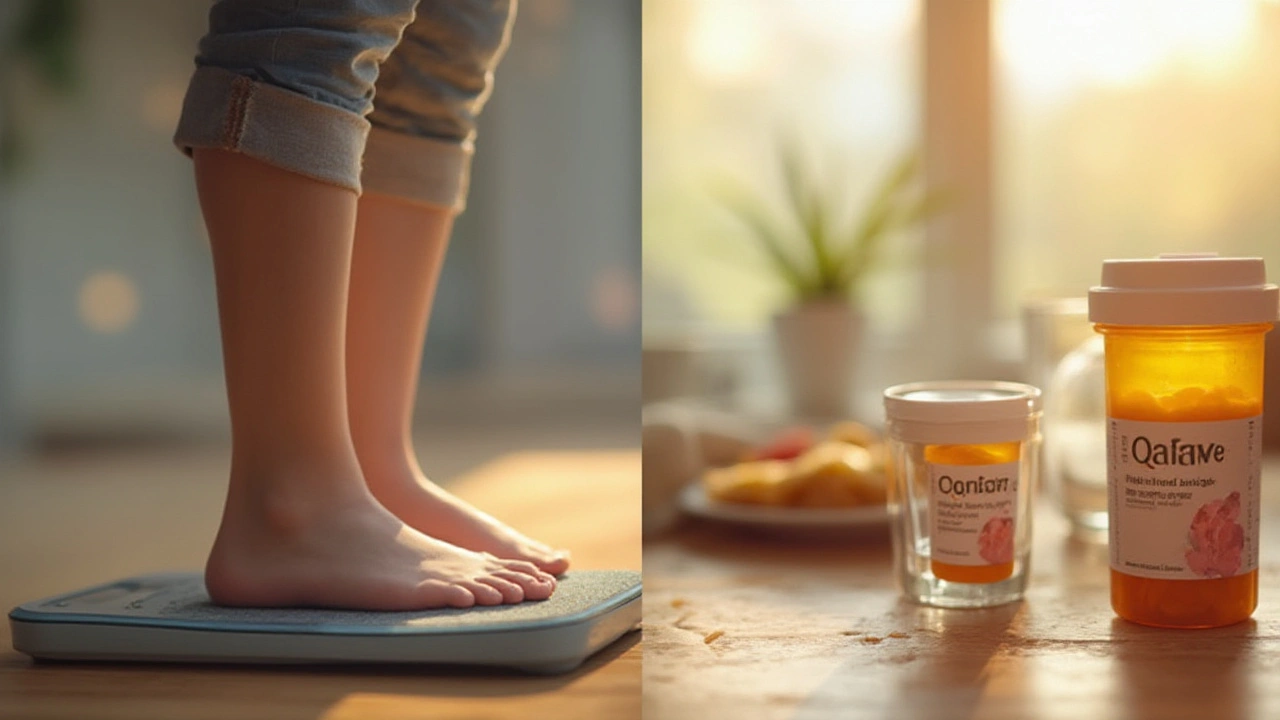Contrave: Uses, Benefits, Side Effects, and How This Weight Loss Medication Actually Works

Pills aren't magic, that’s for sure. But talk about weight loss and suddenly everyone wants a secret shortcut. Diets pop up and vanish faster than new TikTok trends. Yet there’s one option, quietly gaining real-world credibility in doctors’ offices—Contrave. This prescription weight-loss drug isn’t for everyone, but the way it works is worth a close look. Unlike those fads cluttering your social media, Contrave is FDA-approved, carefully studied, and actually changes how your brain talks to your appetite. Most people have never heard these details, even if they’ve spent years fighting to lose pounds. So let’s fill in those gaps—and dig into what Contrave really does, why people use it, what to watch for, and what’s just wishful thinking.
What is Contrave and Who is It For?
Contrave is a prescription-only pill combining two older drugs—naltrexone and bupropion—but it’s packaged specifically for weight loss. The bupropion ingredient is famous for its use in some antidepressants and as a stop-smoking aid. Naltrexone, on the other hand, is best known for helping treat alcohol and opioid dependence. On their own, these two drugs have been around for decades, but together? They target hunger and cravings in a pretty unique way.
This isn’t a pill for someone hoping to “drop five pounds before vacation.” Doctors usually prescribe Contrave for adults who have a body mass index (BMI) of 30 or higher—so, solidly in the obesity range—or someone with a BMI of 27+ who also has weight-related health issues like high blood pressure, Type 2 diabetes, or high cholesterol. The FDA signed off on it back in 2014 after multiple large clinical trials showed people on Contrave lost more weight—on average—than folks only dieting and exercising. What does "more weight" mean? In the biggest studies, about 1 in 4 people dropped at least 10% of their starting weight within a year, while others saw more modest results.
Contrave isn't handed out lightly. Your doctor will ask about your mental health history, check for high blood pressure, and go over what meds you’re already taking. Bupropion, for instance, can up the risk of seizures, so anyone with a seizure disorder—or a history of eating disorders like bulimia—should steer clear. It’s also a no-go for people on certain antidepressants, plus anyone dealing with uncontrolled high blood pressure or withdrawing from alcohol, benzodiazepines, or barbiturates.
The bottom line? Think of Contrave as one piece of a bigger weight-loss puzzle. It’s always prescribed along with advice on diet, exercise, and behavioral changes. Most health insurance plans require evidence of that bigger effort to approve coverage. No physician worth their salt will offer Contrave if you’re not serious about changing habits, too.

How Contrave Works in the Body
This is where Contrave really separates itself from some older weight-loss drugs. You can forget about those old-fashioned “fat blockers” that sent people racing to the bathroom or the jittery stimulants banned for triggering dangerous heart problems. Contrave goes after what's happening upstairs—specifically, in your brain's signaling pathways related to hunger, cravings, and self-control.
Bupropion works by tweaking dopamine and norepinephrine, two chemical messengers you’ve probably heard connected to mood and energy. But it’s not about feeling buzzed. In weight management, bupropion reduces appetite and, for many people, reduces that urge to snack mindlessly. It also comes with a bit of a boost for self-control—key when you’re surrounded by temptations on every side.
Then there’s naltrexone. Surprisingly, it doesn’t act on hunger directly; instead, it blunts the brain’s “reward center.” So when you eat, especially highly palatable foods—think chips, ice cream, greasy takeout—the usual pleasure or “food high” just isn’t as strong. That makes it easier to stick to healthy portions, since the payoff for overeating shrinks.
Together, these two create a double punch: less gnawing hunger plus less joy in comfort eating. Clinical trial MRI scans confirmed that Contrave users showed decreased activation in the brain's reward areas in response to food. You’ll still like your meals, but the urge to eat until you're stuffed gets weaker. That's the real secret sauce—changing those invisible drivers that led so many diets to spiral out of control.
The dose isn’t one-size-fits-all. Doctors usually start you with a lower dose and slowly ramp up over a few weeks. That gives your brain (and stomach) time to adjust. Don’t expect dramatic changes overnight. In fact, manufacturers warn that if you haven’t lost at least 5% of your starting weight after 16 weeks, you and your doctor should seriously rethink whether to stick with Contrave or try something else.
To get real results—and hang onto them—Contrave users have to check in regularly with their doctors. Often, that means monthly weigh-ins or tracking side effects. No two bodies are the same, so individual responses vary. Some lose a chunk of weight, others shed less. Sticking with calorie tracking and at least 150 minutes of moderate exercise weekly hugely boosts your odds.
Now, facing facts: Contrave doesn’t erase cravings completely. If stress hits, donuts still look delicious. But for a lot of people, cravings turn down from “screaming” to more like gentle background music. Day to day, that can mean the difference between giving in and powering through.

Common Side Effects, Safety Tips, and Real-World Experiences
No pill, not even a prescription one, is risk-free. Contrave isn’t shy about its side effects, and some are rougher than others. The big ones pop up within the first few weeks: nausea, headache, constipation, dry mouth, and trouble sleeping. Most people say the nausea is the worst part, but for about half, it calms down after a month as your body adapts.
Less commonly, users mention dizziness, sweaty hands, or higher blood pressure. There’s also a black box warning on suicidal thoughts and behaviors, especially for people under 25 or those with a history of depression. Doctors are serious about screening for this; patients are told to watch for mood swings, new anxiety, or dark thoughts and to check in immediately if these surface.
Getting around the worst side effects takes some trial and error. Some find that taking Contrave with food instead of on an empty stomach cuts nausea. Others spread doses further apart if insomnia’s kicking in. Drinking more water helps with dry mouth and constipation, and dialing back caffeine can make jitters less noticeable. But if you start feeling really off—rapid heartbeat, hallucinations, seizures, or allergic reactions—you need emergency care, not just a phone call to the pharmacy.
One area that doesn’t get enough attention: drug interactions. Contrave can mess with common meds like antidepressants, blood pressure pills, seizure medications, and even some migraine drugs. So be brutally honest about your current prescriptions and over-the-counter supplements before starting.
Plenty of people want to know about drinking. Contrave’s fine with moderate alcohol, but mixing the two ups the risk of seizures or worsens side effects. Heavy drinking is an absolute no, and anyone with a past alcohol issue should only start under expert care.
What about life after Contrave? A lot of real-world users end up taking the medication for a year or more. If the extra weight comes off and stays off—and side effects don’t show up—it’s possible to continue under medical supervision. Others use it as a jumpstart, then wean off once new habits are locked in. The key is not to use it like a “diet pill” for a month and expect lasting success. Contrave is a tool, not a miracle.
Here are some practical tips from folks who stuck with Contrave:
- Keep healthy snacks around; hunger can sneak up unexpectedly as your appetite changes.
- Plan for plateaus—it’s normal for weight loss to slow after two or three months.
- Use an app to track food and mood. Sometimes it’s the little tweaks that show the biggest results.
- Don’t compare your journey to anyone else’s. Some people shed weight faster, others build muscle and see slower scale moves.
- Stick with exercise, even if it’s just a brisk walk most days. It supercharges the effect of Contrave.
The stories you won’t hear in infomercials? People saying Contrave helped them stop overeating at night, made skipping seconds easier, or let them go to a family cookout without dreading every serving tray. It’s not miracle stuff. Yet when you stack it up next to years of failed diets and frustration, it can feel like someone finally turned down the background noise of constant hunger. That won’t show up on the scale, but trust me, you’ll notice it every single day.
If you think you might be a good fit for Contrave, the next step is a real conversation with a doctor who knows your health history, not a quick online quiz. And if you’re not a candidate? That’s fine—weight loss is hard, but there’s no one solution. Smart, supervised strategies (meds or no meds) always beat the latest quick-fix trend.
Curious to hear what it’s like? Look up some real-life testimonials—there’s a vocal crowd sharing stories, tips, and even meal ideas. Just don’t get sucked in by promises that sound too good to be true. Consistency, honesty, and a little patience will take you a lot farther than any single pill, even if that pill really does create a helpful nudge in the right direction.
Craig Hartel
July 23, 2025 AT 22:40I tried Contrave last year after years of yo-yo dieting and honestly? It didn't turn me into a new person, but it turned down the noise. I still craved chips, but I didn't feel like I was fighting a bear to say no. Took me 3 months to notice a difference, but by month 6, I was losing 1-2 lbs a week without starving myself. Big win.
Geethu E
July 25, 2025 AT 16:54As someone from India who's seen 100 'miracle' weight loss pills come and go, I'm skeptical-but Contrave actually makes sense. Bupropion and naltrexone? Those aren't new drugs. They're just being used smartly. My cousin's endocrinologist prescribed it for her PCOS-related weight gain and it worked where metformin didn't. Not magic. Just science.
anant ram
July 25, 2025 AT 19:30Listen, I'm not a doctor, but I've read every study on this, and I've talked to 3 different MDs, and here's the truth: Contrave works best when you're already trying! It's not a cheat code-it's a tool. If you're still eating pizza every night and calling it 'self-care,' no pill in the world will help. You need to show up. The pill just makes showing up easier.
king tekken 6
July 26, 2025 AT 01:07so like... if you think this is the answer, you're just another sheep following the pharma agenda. Big pharma doesn't want you to heal naturally. They want you dependent. Also, did you know the FDA approved this because they got bribed? No? Then you're being manipulated. Also, I lost 40 lbs on lemon water and crying into my pillow. It's all energy.
DIVYA YADAV
July 26, 2025 AT 08:00This is a Western colonial tool disguised as medicine. Why do you think they're pushing this on India now? First they sell us junk food, then they sell us pills to fix the damage. They don't care about our health-they care about profits. Our grandmothers lost weight eating rice, lentils, and walking 10km a day. Now we're told to swallow chemicals? No. We must reject this. This is cultural erasure wrapped in a prescription bottle.
Kim Clapper
July 28, 2025 AT 06:15While I appreciate the clinical precision of this article, I must respectfully challenge its underlying assumption: that pharmacological intervention is a legitimate first-line strategy for weight management. The medical-industrial complex has long prioritized pharmaceutical solutions over systemic behavioral and socioeconomic interventions. This narrative, while superficially rational, perpetuates a dangerous reductionism that ignores the root causes of obesity: food deserts, chronic stress, and income inequality.
Bruce Hennen
July 28, 2025 AT 14:11Contrave’s mechanism is sound, but the 10% weight loss stat is misleading. The average was 5.8%, with 25% hitting 10%. That’s not a success rate-it’s a selection bias. Most people lose 3-5%, plateau, and quit. The trials were funded by Orexigen, the manufacturer. You think they’d publish data showing 80% failure? No. This isn’t medicine. It’s marketing dressed in lab coats.
Jake Ruhl
July 29, 2025 AT 02:45okay so i just want to say that this whole thing is like a trap. like you take the pill and you think youre being saved but really your brain is just being rewired to be dependent on chemicals to feel okay. and then what? you stop and you crash harder than before. and the doctors? they just keep writing scripts like theyre vending machines. and the insurance? they make you jump through hoops but theyll pay for the pill. why? because they dont want to fix the system. they want you to keep buying. its all a loop. and i know this because i saw my sister do it. she lost 30lbs and then gained back 50. now she's on 3 meds. its sad.
Chuckie Parker
July 30, 2025 AT 01:26Contrave is just another corporate scam. America is sick. We're not fat because we eat too much. We're fat because we're lazy. Stop blaming the pill. Stop blaming the system. Blame yourself. If you can't control your appetite, you don't deserve to lose weight. Go lift. Go walk. Go eat less. No magic pills. No excuses.
Evelyn Shaller-Auslander
July 31, 2025 AT 11:01My mom took this for 9 months. Nausea was brutal at first, but she stuck with it. Lost 28 lbs. Now she walks 5 miles every morning. She says the pill helped her stop eating when she wasn't hungry. That’s the real win-not the number on the scale, but the quiet freedom from constant craving.
Gus Fosarolli
August 1, 2025 AT 06:15So let me get this straight-you’re telling me the solution to our epidemic of emotional eating is… a drug that makes food less fun? Brilliant. Next they’ll make a pill that makes Netflix less addictive. At this point, I’m just waiting for the ‘I’m too tired to feel emotions’ patch.
George Hook
August 1, 2025 AT 19:37What’s rarely discussed is how long-term use affects dopamine sensitivity. If you’re dampening the reward response to food for years, what happens when you stop? Do you become numb to all pleasure? Or do you just go back to craving more intensely? The long-term neurobiology here is still a black box. We’re treating symptoms without understanding the deeper neurological adaptations. That’s not medicine. That’s temporary patching.
jaya sreeraagam
August 2, 2025 AT 06:13Hey! I’m from Hyderabad and I’ve been on Contrave for 8 months now. I lost 35 lbs and my diabetes meds were cut in half. Yes, I had nausea at first. Yes, I had trouble sleeping. But I started meal prepping, walked daily, and tracked my moods in a notebook. The pill didn’t do it alone. It gave me the mental space to build real habits. If you’re struggling, don’t give up. Start small. One healthy meal. One walk. One day at a time. You got this!
Katrina Sofiya
August 2, 2025 AT 11:50Thank you for this incredibly well-researched and compassionate breakdown. As a healthcare provider, I see too many patients who have been failed by fad diets and misinformation. Contrave, when used appropriately within a multidisciplinary framework, is one of the most promising tools we have. It’s not a cure, but it’s a bridge-and bridges are vital when the road ahead is long.
kaushik dutta
August 2, 2025 AT 15:53From an Ayurvedic perspective, this is a classic example of suppressing symptoms without addressing dosha imbalance. Kapha aggravation leads to weight gain. Bupropion is a stimulant (Vata-increasing), naltrexone is a depressant (Kapha-increasing). The combination creates a temporary equilibrium, but without dietary rhythm (dinacharya), it’s unsustainable. The real solution? Morning lemon water, bitter greens, and sunrise yoga. Not a pill.
doug schlenker
August 3, 2025 AT 00:43I’ve been on this for 11 months. I lost 42 lbs. The side effects? Nausea for the first month, then gone. The real change? I stopped eating when I was full. I used to eat until I felt sick. Now I feel… calm. I still have bad days. But now I have tools. I’m not cured. But I’m not drowning anymore.
Olivia Gracelynn Starsmith
August 3, 2025 AT 18:27For anyone considering this, track your sleep. Bupropion messes with REM. I didn’t realize how much I was relying on poor sleep to cope with stress until it got worse. Then I started meditation and cut caffeine after 2pm. That did more for my cravings than the pill ever did.
Skye Hamilton
August 4, 2025 AT 12:59They say it’s not magic-but what if it’s just the placebo effect? What if people lose weight because they believe they’re being ‘fixed’? What if the real drug is hope? And what if hope is the only thing that ever worked?
Maria Romina Aguilar
August 6, 2025 AT 10:39Wait-so if you’re on antidepressants, you can’t take this? But what if you’re depressed because you’re overweight? What if you need both? What if the system is designed to make you choose between your mental health and your body? This isn’t medicine. It’s a trap.
Chris Kahanic
August 7, 2025 AT 22:52Contrave doesn’t make you lose weight. It makes you stop fighting yourself. That’s the difference.